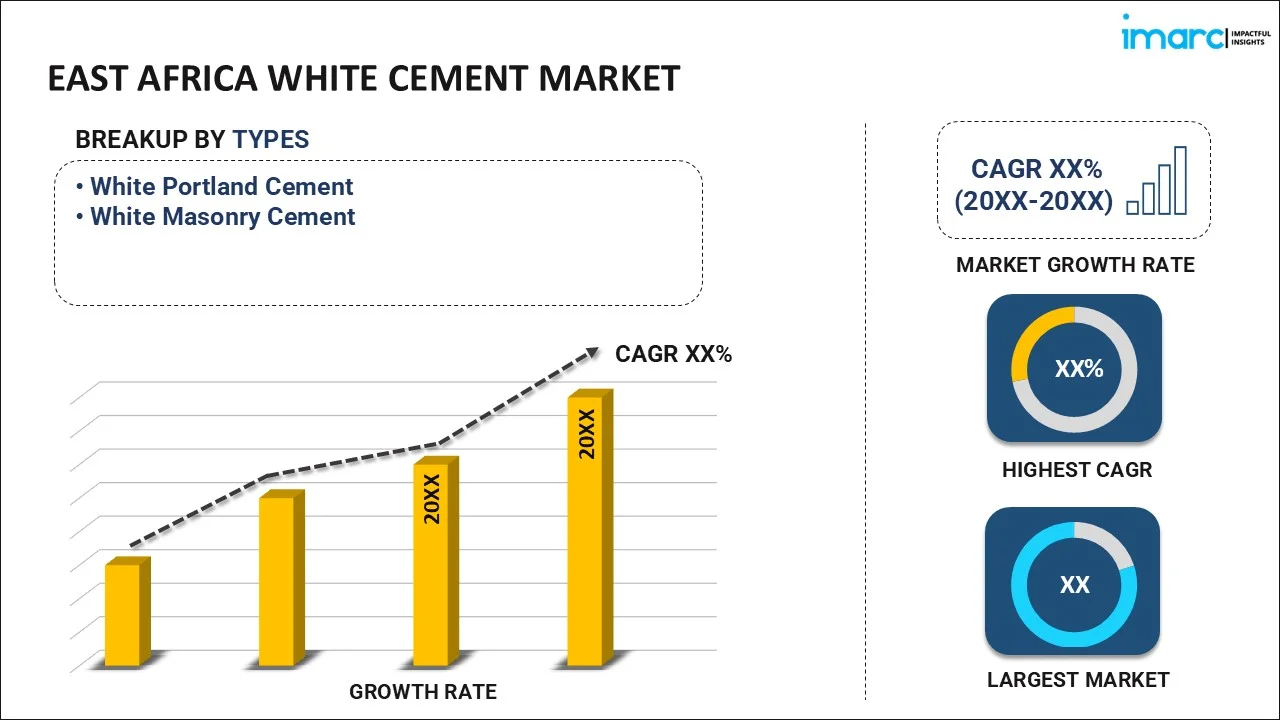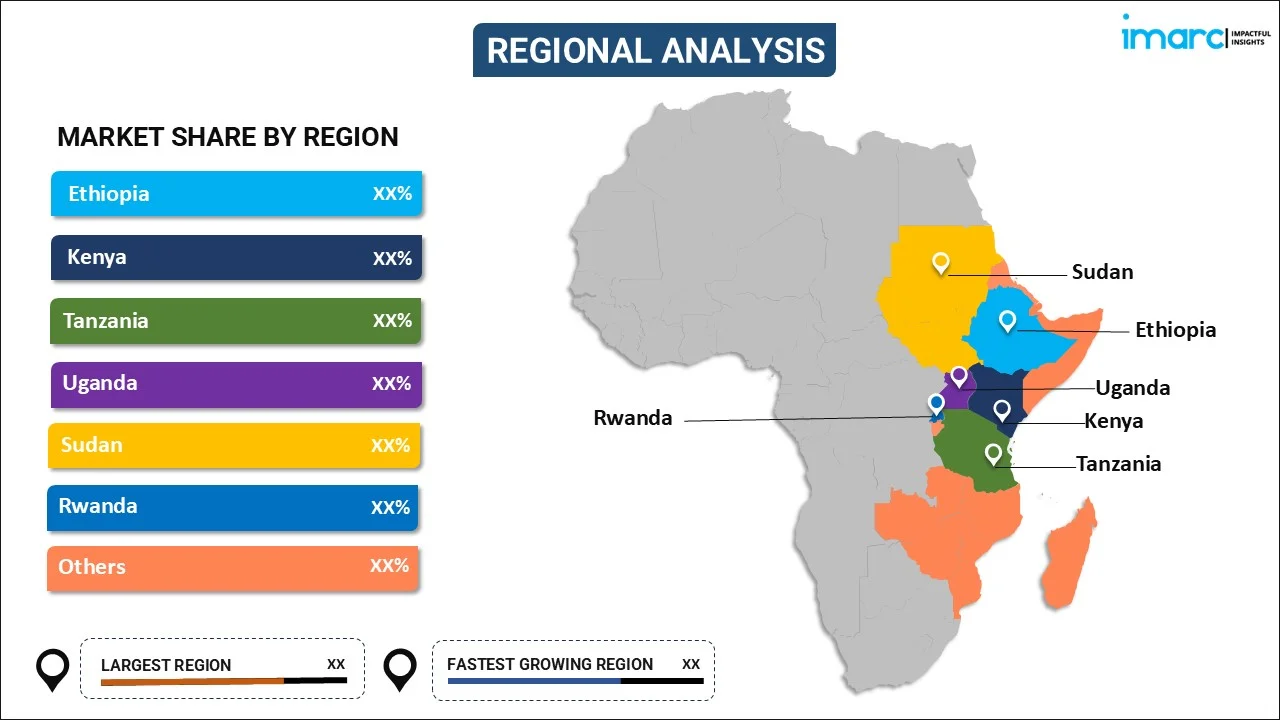
East Africa White Cement Market Report by Type (White Portland Cement, White Masonry cement), Sector (Residential, Commercial, Industrial), Application (Whitewashing, Skimming, Grouting, Sculptures, and Others), and Region 2025-2033
Market Overview:
The East Africa white cement market size reached USD 14.2 Million in 2024. Looking forward, IMARC Group expects the market to reach USD 25.5 Million by 2033, exhibiting a growth rate (CAGR) of 6.35% during 2025-2033.
|
Report Attribute
|
Key Statistics
|
|---|---|
|
Base Year
|
2024
|
|
Forecast Years
|
2025-2033
|
|
Historical Years
|
2019-2024
|
|
Market Size in 2024
|
USD 14.2 Million |
|
Market Forecast in 2033
|
USD 25.5 Million |
| Market Growth Rate 2025-2033 | 6.35% |
White cement is produced from raw materials such as china clay, chalk, white limestone and with materials that contain a low content of coloring elements such as iron oxide and manganese oxide. These oxides influence whiteness and undertone of the white cement. It is more expensive than standard portland cement because of the different manufacturing techniques involved. Apart from this, due to its excellent aesthetic, decorative and hydraulic binding properties, it is increasingly being used for producing structural and architectural concrete, as well as masonry and cementitious building products in East African countries. In addition, increasing construction and reconstruction activities coupled with rapid industrialization is further expected to boost the white cement market in the coming years.
Key Market Segmentation:
IMARC Group provides an analysis of the key trends in each sub-segment of the East Africa white cement market report, along with forecasts at the regional and country level from 2025-2033. Our report has categorized the market based on type, sector and application.
Breakup by Type:

- White Portland Cement
- White Masonry cement
Amongst these, white portland cement represents the biggest segment, accounting for the largest market share.
Breakup by Sector:
- Residential
- Commercial
- Industrial
Residential sector currently accounts for the largest share in the East African white cement market.
Breakup by Application:
- Whitewashing
- Skimming
- Grouting
- Sculptures
- Others
Whitewashing currently holds the largest market share in the East African white cement market.
Breakup by Region:

- Ethiopia
- Kenya
- Tanzania
- Uganda
- Sudan
- Rwanda
- Others
The report has also provided a comprehensive analysis of all the major regional markets, which include Ethiopia, Kenya, Tanzania, Uganda, Sudan, Rwanda, and Others.
Competitive Landscape:
The report has also examined the competitive landscape of East Africa white cement market.
IMARC Group’s latest report provides a deep insight into East Africa white cement market covering all its essential aspects. This ranges from macro overview of the market to micro details of the industry performance, recent trends, key market drivers and challenges, SWOT analysis, Porter’s five forces analysis, value chain analysis, etc. This report is a must-read for entrepreneurs, investors, researchers, consultants, business strategists, and all those who have any kind of stake or are planning to foray into East Africa white cement market in any manner.
Report Coverage:
| Report Features | Details |
|---|---|
| Base Year of the Analysis | 2024 |
| Historical Period | 2019-2024 |
| Forecast Period | 2025-2033 |
| Units | Tons, Million USD |
| Segment Coverage | Type, Sector, Application, Country |
| Countries Covered | Ethiopia, Kenya, Tanzania, Uganda, Sudan, Rwanda, Others |
| Customization Scope | 10% Free Customization |
| Post-Sale Analyst Support | 10-12 Weeks |
| Delivery Format | PDF and Excel through Email (We can also provide the editable version of the report in PPT/Word format on special request) |
Key Questions Answered in This Report
The East Africa white cement market was valued at USD 14.2 Million in 2024.
We expect the East Africa white cement market to exhibit a CAGR of 6.35% during 2025-2033.
The growing adoption of white cement in construction and renovation activities, as it is heat resistant and provides high aesthetic appearance, is primarily driving the East Africa white cement market.
The sudden outbreak of the COVID-19 pandemic had led to the implementation of stringent lockdown regulations across the region resulting in the temporary halt in numerous construction activities, thereby limiting the demand for white cement.
Based on the type, the East Africa white cement market can be segmented into white Portland cement and white masonry cement. Currently, white Portland cement holds the majority of the total market share.
Based on the sector, the East Africa white cement market has been divided into residential, commercial, and industrial. Among these, the residential sector currently exhibits a clear dominance in the market.
Based on the application, the East Africa white cement market can be categorized into whitewashing, skimming, grouting, sculptures, and others, Currently, whitewashing accounts for the largest market share.
On a regional level, the market has been classified into Ethiopia, Kenya, Tanzania, Uganda, Sudan, Rwanda, and Others.
Need more help?
- Speak to our experienced analysts for insights on the current market scenarios.
- Include additional segments and countries to customize the report as per your requirement.
- Gain an unparalleled competitive advantage in your domain by understanding how to utilize the report and positively impacting your operations and revenue.
- For further assistance, please connect with our analysts.
 Inquire Before Buying
Inquire Before Buying
 Speak to an Analyst
Speak to an Analyst
 Request Brochure
Request Brochure
 Request Customization
Request Customization




.webp)




.webp)












